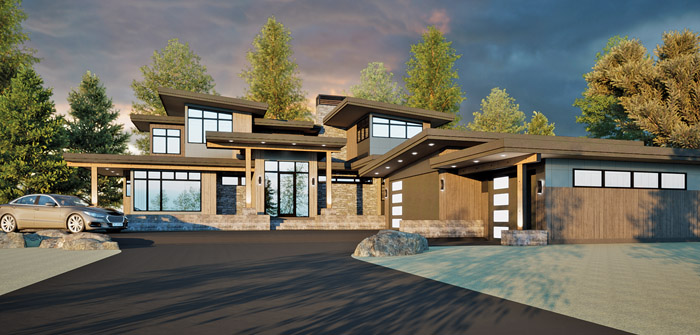(Buccafumi aims for designs that are a blend of clients’ personality and lifestyle | Rendering courtesy of Vellum Design Studio)
When asked what makes the difference between a good house and a great house, residential designer Nicholas Buccafumi didn’t hesitate. “Great homes can evoke an emotion when finished. They’re something you want to experience, photograph, and view over and over again. A great house can embody an art form, a landscape, and a safe retreat — all at the same time. Given that distinctiveness, it can even become a timeless piece of art.”
Since starting his own firm, Vellum Design Studio — which is “dedicated to designing the finest custom homes” in Central Oregon and the Greater Pacific Northwest — Buccafumi has come to expect clients who are “discerning and sophisticated.” And they, in turn, “expect things to be done thoughtfully and professionally — a custom home done right.”
The key to their satisfaction and his success is, in Buccafumi’s words, “leading clients through the entire process — from initial site consultation to receiving permitted drawings. My ten-plus years of designing custom homes enables me to provide truly unique designs for each project. Most importantly, my construction plans are meticulously detailed and professionally drafted. I know what the guys in the field need, and that allows me to draft accurately so expectations are clearly communicated.”
To backtrack, Buccafumi is a first-generation American whose parents were immigrants (his father from Italy, his mother from Poland), taught themselves English, worked, and went to school. His father — an industrial engineer for the post office, first in New York City, and then Portland — “instilled in me the hard work ethic, and sparked my curiosity for all things design.”
Buccafumi had his own drafting table as a kid, “which really fueled my creativity. I quickly became fascinated by all things related to construction, engineering, and architecture. At 12 years old, he recalled “spending hours outside, sketching historic homes in my neighborhood.” He also enjoyed “getting my hands dirty, and working to rebuild a fence, pour concrete, and framing retaining walls.” Later on, he did hands-on construction work that included mechanical and electrical positions.
Although Buccafumi initially studied civil engineering, he changed direction to construction engineering management as “I wanted to be in the field, not behind a desk,” and eventually transitioned to architecture — “where I found my true calling.”
“I saw a lot of errors in commercial and residential architectural plans,” he said. “They were convoluted, and didn’t provide details on key elements. Often, plans would simply read ‘waterproof deck’ without indicating crucial details such as framing, decking, slope, or connections. They demonstrated architectural flair without insight on how structures actually get built. I believed in my heart that there was a better way of doing things.”
To elaborate, “my aim is to provide drawings that demonstrate what needs to be built in a clear and concise way with all the necessary details and notation. This ensures that even complex projects are executed professionally, bid accurately, and scheduled realistically. I’m one of the only local designers with that knowledge.”
When initially talking with clients, Buccafumi “dives into their stage of life and how they operate day to day. Are clients still working, or approaching retirement? Are they seeking a vacation home in Caldera Springs, or a place to settle down in Brasada Ranch? What are their hobbies? Do they enjoy hosting? Desire an in-home art or fitness studio? What I design should be an expression of both their personality and lifestyle.”
And while Buccafumi “personally enjoys the high-desert aesthetic that incorporates natural wood, large beams, deep overhangs, and natural stone, I don’t stick to a particular style — so there is freedom to work across different architectural styles. I always aim, however, for designs that limit disruption to the natural landscape, and blend in with their surroundings. I design with a pretty broad lens,” he said.
In doing so, Buccafumi has made it a priority to “utilize the best computer-aided design (CAD) and state-of-the-art 3-D visualization programs (having first appreciated early versions of this technology as a design tool in college). Programs have become so much more sophisticated and realistic, allowing you to see color and texture, as well as proportion,” he said. “Many, however, require a higher learning curve, but I enjoy staying up to date with software as it results in the best product for my clients.”
Even though Vellum Design is becoming well established, Buccafumi admitted that “I was hesitant initially, as it sounded too stressful. But I’ve found my true calling and profession, which has brought me so much joy and fulfillment. I’m truly passionate about what I do, and that’s something you can’t fake.”



